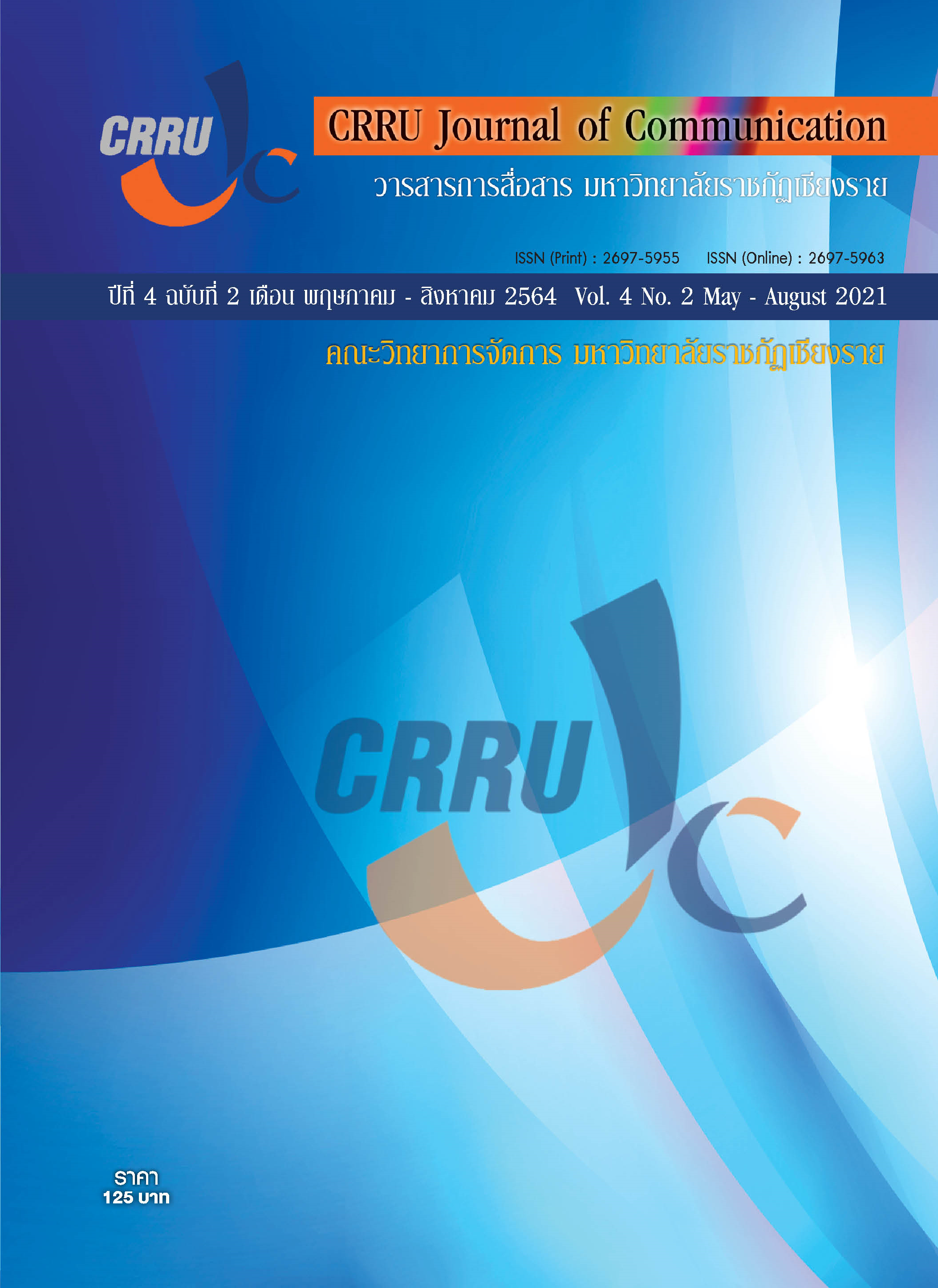English Pronunciation Abilities of Chinese Undergraduate Students in Thai Environment
Main Article Content
Abstract
The research titled “English Pronunciation Abilities of Chinese undergraduate students in Thai Environment” objective was to identify the problems in pronunciation learning encountered for Chinese undergraduate students in Chiangrai Rajabhat University. The samples used in the study were 40 third-year Chinese undergraduate students in Chiangrai Rajabhat University with no official English proficiency in 2021. The samples were selected using simple random sampling. The research tools were a survey questionnaire and a structured interview with a quantitative survey research design. This data was analysed with frequency, percentage, mean, standard deviation and a content analysis. The results showed that the students often use strategies for coping with speaking and listening problems, but used negotiation for meaning while speaking the most rather than other strategies. Learning more the Thai language and culture were one of the priority and initially employed a set of strategies to deal with and to solve all these problems by using English at first and trying to speak Thai and appreciate the differences such as language and religion.
Article Details
References
Arwae; S, Chinwonno; A. (2013). Development of reading materials to enhance English reading ability of students in Three Southern border provinces of Thailand. Chulalongkorn University.
Chiangrai Rajabhat University (CRRU). (2014, June 10). Annual Report on Working Planning Management. Retrieved July 15, 2014 from http:/www.cru.in.th/mou/index.asp.
Creswell, J.W. (2012). Educational research: Planning, conducting, and evaluating quantitative and qualitative research. (4th Ed.).
Cohen, A.D. (2012). Test Taker Strategies and Task Design. In: Davidson, F.; Fulcher, G. (eds), The Routledge Handbook of Language Testing. Oxford: Routledge
Cooper, A. J., Duke, É., Pickering, A. D., and Smillie, L. D. (2014). Individual differences in reward prediction error: contrasting relations between feedback-related negativity and trait measures of reward sensitivity, impulsivity and extraversion. Front. Hum. Neurosci. 8:248. doi: 10.3389/fnhum.2014.00248.
Gilakjani, A.P. (2016). The Significance of Listening Comprehension in English Language Teaching. Journal Paper. 1674-1675. Retrieved
December 27, 2016 from http://www.academypublication.com/ojs/ index.php/tpls/article/view/tpls060816701677/852.
Jenkins, J. (2014). English as a lingua franca in the international university: The politics of academic English language policy. Routledge.
Mirzaei, A., & Heideri, H. (2012). Exploring the use of oral communication strategies by (non) fluent L2 speakers. The journal of Asia TEFL, 9(3), 131-156.
Mustaffa, C. S., &Ilias, M. (2013). Relationship between students adjustment factors
and cross cultural adjustment: a survey at the northern university of
Malaysia. Intercultural Communication Studies XXII: 1, 279 –300.
Nakatani, Y. (2010). Identify strategies that facilitate EFL learners’ oral communication: A classroom study using multiple data collection procedures. The Modern Language Journal, 94, 116-136.
Nookam. (2010). The effects of speaking rate on listener evaluations of native and foreign-accented speech. Language Learning, 48, 159-182.
Oxford, R L (1990). Language learning strategies: What every teacher should know.
New York: Newbury House.
Ryshina-Pankova. S. (2018). Discourse moves and intercultural communicative
competence in telecollaborative chats. Language Learning
& Technology, 22 (1), 218–239.
Stanley, G. (2013). Language Learning with Technology – Ideas for Integrating
Technology in the Classroom. Cambridge: Cambridge University Press.
The Quality Assurance Agency for Higher Education. (2019, January 19). Country Report:
Thailand. Retrieved April 10, 2020, from http://www.mua.go.th/know_ohec/ohec.html.
Thorne, S. L. (2010). The ‘Intercultural Turn’ and Language Learning in the Crucible of New Media. In F. Helm & S. Guth (eds.),
Telecollaboration 2.0 for Language and Intercultural Learning (pp. 139-164).
Wang, Y. (2012). Chinese speakers' perceptions of their English in intercultural
communication. Doctoral thesis. University of Southampton.
Wen-Hsing Yang. (2015). The effects of speaking rate on listener evaluations of native
and foreign-accented speech. Language Learning, 48, 159-182.
Wu, Ying. (2010). Er Yu Xi De Zhong Mu Yu Fu Qian Yi Xian Xiang Ji Dui Ce Yan Jiu (A Study of L1 Transfer in Second Language Learning and the Strategies). Journal of Chongqing University of Science and Technology. Social Sciences Edition, (2), 188-189.
Xie, X & Fowler, C., A. (2013). Listening with a foreign-accent: The inter language
speech intelligibility benefit in Mandarin speakers of English, Journal of
Phonetics, 41(5), 369-378.
Ussama., R. (2013). Timing patterns in the production of a foreign language. Views on the Acquisition and Use of a Second Language (pp. 539-551). Universitat Autonoma de Barcelona.
Yangklang, W. (2006). Improving English Final /-l/ Pronunciation of Thai Students
through Computer-Assisted Instruction Program. Thesis, M.A. (ELS), Suranaree University of Technology.


